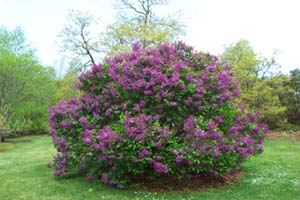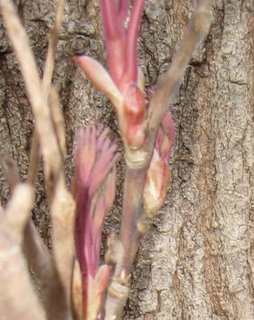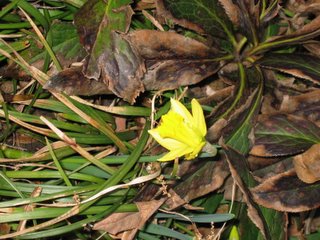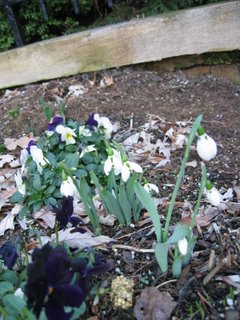Biltmore Triangle Garden
There is a beautiful flower garden at the corner of Biltmore Street and 20th Street in Adams Morgan. A group of plant-passionate volunteers tends the beds. The neighbors come to sit on the bench and admire the flow of seasons. Join us for pictures and gardeners' notes.
Friday, February 24, 2006
Monday, February 20, 2006
Shady
What will we do with the shade garden? It doesn't have much sun and it is dry and crowded with tree roots. Let alone that dang poison ivy that KL and probably others keep pulling out. We've put down some hostas to vary the liriope. And there is some ajuga that was planted to one side. The lilac that was suffering behind the bench has been moved, and there is a tree peony and spring bulbs including Angelique tulips. What should replace the lilacs, if anything? Suggestions include:
Camellia
Bugbane (Cimicifuga--now known as Actae)
Variegated ground covers.
Other suggestions for dry shady spots
At the meeting, we voted for a camellia, which will offer shade and seasonal variety. However, they can be chancy to grow in this climate. It is a risk. But we saw one in bloom on Biltmore Road, late January.

Cimicifuga
JF prefers cimicifuga and suggests that water-retaining crystals would compensate for the dryness behind the tree.
Other Ground Covers
We heard from a foreign correspondent who suggested
“ I do know the spot you are working on - I have noticed it when visiting …in DC. People are doing similar things in open spaces in London. Under the tree you might consider: variegated vinca, variegated pachysandra or even variegated ivy. But I understand you are under snow just now! Best, RM”
More information on cold-hardy camelias from
- Roslyn Nursery Catalog
- American Camellia Society
- Camellia Society of the Potomac Valley (a little out of date)
- and a current Virginia Camellia Society - Calendar
 The Camellia Society of the Potomac Valley Annual Camellia Flower Show and Plant Sale is at the Brookside Gardens, 1800 Glenallen Ave., Wheaton, MD on
The Camellia Society of the Potomac Valley Annual Camellia Flower Show and Plant Sale is at the Brookside Gardens, 1800 Glenallen Ave., Wheaton, MD onSaturday, March 11 (10:00 AM to 5:00 PM) and Sunday, March 12 (10:00 AM to 4:00 PM)
Dry Shade Garden Resources
- http://landscaping.about.com/od/plantsforshadyareas/
- http://www.bbg.org/gar2/topics/plants/handbooks/shady/3.html
- http://forums.gardenweb.com/forums/shade/nph-ind.cgi?n=200
- http://www.eastendcommunity.com/plants/shade_garden.htm
- http://www.savvygardener.com/Features/shade_gardening.html
- http://www.plantideas.com/shade/shade.html
- http://www.gonegardening.com/xq/ASP/group_id.21/article_id.97/referer./qx/gg_shop/article.htm
- http://www.uri.edu/ce/factsheets/sheets/perenialspec.html
- http://www.backyardgardener.com/shade/shade.html
- http://www.flower-gardening-made-easy.com/Shade-gardening.html
Wednesday, February 08, 2006
Gardening questions: Pruning
One question that came up at the meeting was whether and when to prune. We particularly wondered if we should be pruning roses now, and when the best time was for lilacs.
After a little research here's what we learned.

Pruning Lilacs
Lilacs should be pruned immediately after they bloom, because the buds (for next year's flowers) blooms on new wood.
We are marginal for lilacs in DC, and the heat makes them prone to mildew which is unsightly but not particularly harmful. In Maine, where they thrive, KL had a hedge that had gotten overcrowded and bloomed very little. A neighbor told her to root prune--ditch along the edge of the hedge with a cutting spade. She did and had a glorious display the next year. It was also a message to divide and donate.

Pruning Roses
Roses should be pruned at various times throughout the year according to the National arboretum:
"Lightly in autumn, removing canes long enough to be whipped by winter winds and those canes with signs of disease. Pruning to remove remaining dead, diseased, and damaged canes is done in early to mid-March just before growth starts. Species and climbing roses are pruned by removing entire canes all the way to the ground to encourage an open, vase-shaped habit. The rest of the roses get pruned to knee height at an outward facing bud. You can do some light pruning to shape the plants during the summer as needed."
Tuesday, February 07, 2006
Garden Meeting February 1

The Biltmore Triangle Gardeners met on February 1 to plot out the 2006 garden. That is...the plots are already there, but we wanted to plan our plants.
We decided that, while individual gardeners would continue to experiment and refine their plots, we would focus on three projects for the garden overall:
- Reseed the grass, which has gotten weedy and spotty. Between us, there was no lawn expertise so we hope that someone reading this has suggestions about how to deweed and reseed. (We will probably return to a discussion of pavers or other alternatives, especially between some of the plots that come close together, at some point in the future.)
- Landscape the (dry) shade garden behind the bench-We decided we would all work on it;
- Have flowering plants all seasons--especially mid to late summer, which can be hard to sustain. We will fill in with a mix of perenniels and annuals.
The idea of a camelia for the shady back end, to replace a lilac that will be moved into the sun, carried the day. However, there is still some discussion under way about the use of other plants such as black cohosh and variegated ground covers. Since they all have very different habits and bloom or feature times, it is possible all will go there.
We also discussed reaching out to the community including building ties to local florists and landscapers, and perhaps having a garden party to celebrate blooms, bring garden fans together, and honor a neighborhood garden notable.




 dancing daffodils
dancing daffodils  snowdrops waiting for snow
snowdrops waiting for snow 